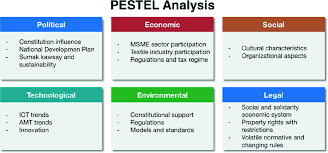PESTEL Factors - External Analysis
What are the PESTEL Factors?
- Marketing, Advertising, Sales & PR
- Accounting, Taxation, and Reporting
- Professionalism & Career Development
-
Law, Transactions, & Risk Management
Government, Legal System, Administrative Law, & Constitutional Law Legal Disputes - Civil & Criminal Law Agency Law HR, Employment, Labor, & Discrimination Business Entities, Corporate Governance & Ownership Business Transactions, Antitrust, & Securities Law Real Estate, Personal, & Intellectual Property Commercial Law: Contract, Payments, Security Interests, & Bankruptcy Consumer Protection Insurance & Risk Management Immigration Law Environmental Protection Law Inheritance, Estates, and Trusts
- Business Management & Operations
- Economics, Finance, & Analytics
What is the External Environment or Macro-Environment of a Firm?
The external environment includes the external factors that can indirectly influence an organization.
The external environment is often divided into:
- Political (Governmental or or Legal) Factors
- Economic Factors
- Socio-Cultural Environment
- Technological Factors
- Competitive Factors
What is PEST (PESTEL) Analysis of Business Strategy?
The PEST (or PESTEL) analysis is a method or approach to identifying the external factors that affect a firms operations or ability to enter into a business market or industry. This analysis was introduced by Dr. Francis Aguilar in 1967. PEST is an acronym that stands for Political, Economic, Socio-Cultural, and Technological factors. The PESTEL analysis adds Environmental and Legal considerations to the analysis. Other variations include adding Demographic and Ethic factors (STEEPLED analysis), or International and Demographic factors (PESTLIED), or Local, National, and Global factors (LONGPESTLE analysis). These tests identify environmental factors affecting the business.
The PEST analysis is outward-looking (unlike the SWOT analysis, which is inward-looking) and evaluates the business environment. This can help the firm to identify opportunities and threats created by the environment. It also allows a firm to modify its strategy to fit in an existing market or develop a strategy for a market that it intends to enter.
What are Political and Legal Factors?
These factors are quite similar; so I will deal with them collectively. These two factors concern the state of the law and political opinion towards issues. Laws are constantly changing and evolving. Statutory law comes from legislators, regulations come from the executive branch, and common law interpretations of business issues come from the courts.
This mix leads to regular changes in the business law environment. Examples of political or legal factors include government spending (program funding, grants, government contracts), tax policy, securities laws, employment or labor law, financial regulations, environmental regulations, specific industry regulations, etc. The best way to stay apprised of political or legal opportunities and threats is to regularly read newspapers and magazines about politics and the state of the law.
What are Economic Factors?
Economic factors include the health of the relevant economy (local, national, international). The state of the economy affects many factors that are important to business, such as consumer demand, government spending, tax rates, interest rates, etc. Each of these sub-factors is important for unique reasons. Some of the factors are positive and create opportunities. For example, increased customer demand may signal a chance for higher prices or new hiring to meet the demand. Other factors are negative and raise the cost structure of the business. For example, rising interest rates may cause the cost of capital to rise and ultimately raise the cost of production.
What are Socio-Cultural Factors?
This includes psychological preferences or dispositions that change in the business environment that are attributable to some sociological or cultural change. Examples of such changes include: an aging population, population growth rate, new information on healthy living (diets, exercise, medicine, etc.), educational standards, growth of communication methods (e.g., Facebook), job or career shifts (manufacturing to service economy), etc.
What are Technological Factors?
Technological factors change the way things are done. Robotics effects manufacturing the way information technology affects communication methods. These changes affect barriers to entry, cost structures, geographic reach, forming new business models, worker locations, etc.
What are Environmental Factors?
Environmental factors change the operating environment or the requirements on businesses. Lesser regulations may lower operational costs, while heavier regulations may raise costs and add administrative burdens to carrying on a business. On the other hand, a focus on green living has sparked many new businesses, ranging from the recycling of products to green product development.
Summary Diagram of the PEST Analysis

Related Topics
- How Strategies Arise
- Intended, Deliberate, Realized, and Emergent Strategies
- Management and Strategic Planning
- Mintzberg's Schools of Strategic Development
- Design School
- Planning School
- Positioning School
- Entrepreneurial School
- Cognitive School
- Learning School
- Power School
- Culture School
- Environmental School
- Configuration School
- Mintzberg's 5Ps of Strategy
- McKinseys 7s Model
- ***Industry Analysis to Build a Strategy***
- Strategic Analysis
- SWOT Analysis
- SPACE Analysis
- Situational Analysis - 7C
- Competition Profile Matrix
- Stakeholder Analysis
- Stakeholder Mapping
- Resources and Capabilities
- VMOST
- Core Competency
- VRIO Analysis
- Value Chain Analysis
- Internal Factor Analysis
- Value Creation Index
- Minimum Efficient Scale
- PEST(LE) Analysis
- Industry Lifecycle Analysis
- Company Lifecycle - Definition
- Porter's Five Forces
- Modes of Management
- External Factor Evaluation
- Business Performance Measurement
- Benchmarking
- Balanced Scorecard
- Economic Value Added
- Activity-Based Management
- Quality Management
- Action Profit Linkage Model
- Business Activity Monitoring
- Gap Analysis
- Strategy Diamond
- BCG Growth-Share Matrix
- GE McKinsey Matrix
- Value Reporting Framework
- Pyrrhic Victory